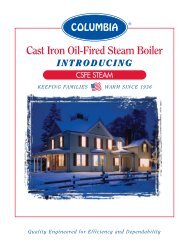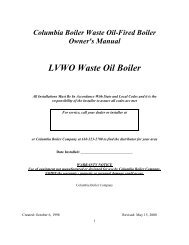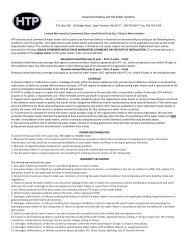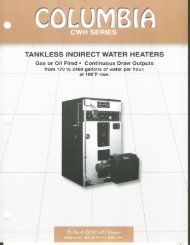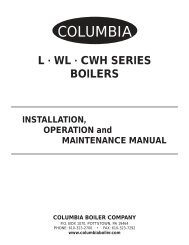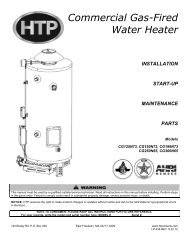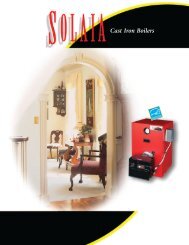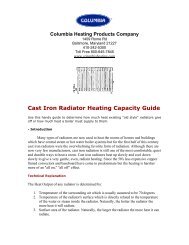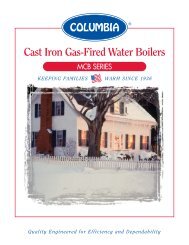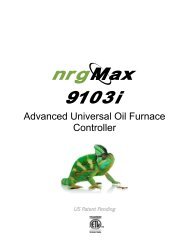CSVB Series II - Columbia Heating
CSVB Series II - Columbia Heating
CSVB Series II - Columbia Heating
- No tags were found...
You also want an ePaper? Increase the reach of your titles
YUMPU automatically turns print PDFs into web optimized ePapers that Google loves.
MAINTAINING YOUR BOILERBurnersBeginning of heating season visually check pilot end mainburner flames. See Figures 14, 15 & 16 Pages 26 & 27.Safety Relief ValveTest safety relief valve for proper operation. Refer to valvemanufacturer’s instructions packaged with relief valve.Expansion Tank (Non-diaphragm)Tank may become waterlogged, or may receive excessof air. Frequent automatic opening of safety reliefvalve indicates water logging. High boiler temperatureaccompanied by unusually low radiation unit temperature(and “knocking”) indicates excess air in tank.To correct:1. Close valve between boiler and tank. Drain tank untilempty.2. Check all tank plugs and fittings. Tighten as necessary.3. Open valve between boiler and tank. Water will rise tonormal height in tank if you have automatic fill valve(otherwise, manually refill system).Boiler Flue PassagesRecommend following checked annually by qualified serviceagent.• flue passages• burner adjustment• operation of controlsBefore start of each season (or whenever system has beenshut down for some time) recheck whole system for leaksand recheck boiler and vent pipe for leaks. Replace or patchany boiler seals that are faulty. Before start of each season(or whenever system has been shut down for some time)recheck the whole system for leaks . . . and recheck theboiler and vent pipe for leaks. Replace or patch any boilerseals that are faulty.Vent PipeVenting and piping should be checked at least monthly. Ifvent piping shows any sign of leaking, replace immediately.Water SystemIf system is to remain out of service during freezingweather, always drain it completely (water left in to freezewill crack pipes and/or boiler).Cleaning Your Boiler And BurnersFlue passages between sections should be examined yearlyand cleaned if necessary.To clean:• Remove burners, pilot, and vent pipe.• Remove top and front jacket panels.• Remove two screws attaching intermediate front panelto left and right side jacket panels.• Remove control panel as a unit.• Remove draft diverter and intermediate front panel.• Carefully remove cerafelt gasket strips.• Clean passageways between sections with flexiblehandle wire brush. Remove dirt from bottom of boilerand from between sections by vacuuming.• Verify all flame ports in burners are open and clear.Shake out or blow out all loose dirt in burners.• Reseal seams between adjacent sections as necessarywith 400 ° F RTV silicone sealant.• Reassemble all parts.• Verify tightness of pilot connections and condition ofburner flames after reassembly. See Figures 15 and 16.• Verify vent pipe connections to chimney are secure andno obstructions are present.BlowerBlower motor features permanently lubricated ball bearingconstruction. Lubrication is not required.Circulator Pump Isolation ValvesOperate isolation valves in circulator pump flanges manuallyonce or twice per year to prevent valves from becomingstuck in open positionRotate valves from open position to closed position andback to open position.Low Water Cutoff(s)Inspect field sourced low water cutoffs annually oras recommended by low water cutoff manufacturer.Flush float type low water cutoff(s) per manufacturer’sinstructions.Housekeeping• Keep boiler area clear and free from combustiblematerials, gasoline and other flammable vapors andliquids.• Keep boiler area clear of debris and other materialsobstructing flow of combustion and ventilation air.28



